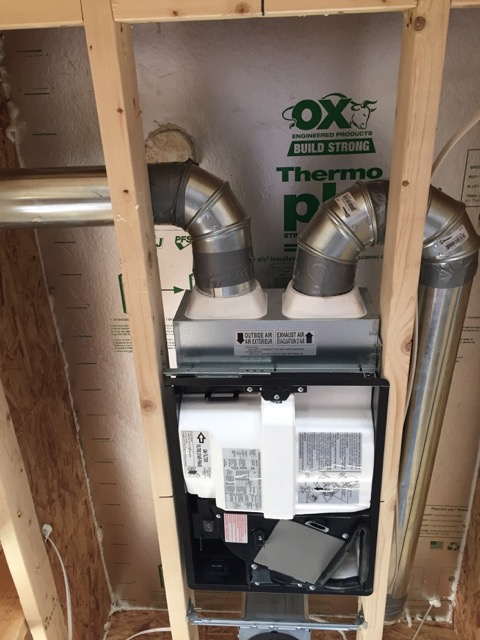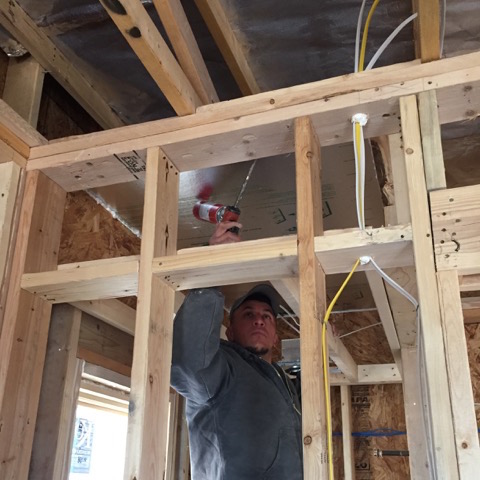Getting Mechanical Ventilation Inside Conditioned Space

If you’ve been hanging around here for a while, you know I encourage architects and builders to find a way to get the ductwork and heating and cooling systems inside the conditioned space of a home. In cold climates, this usually happens without much argument. In hot and warm climates, we’re not there yet. But there’s another aspect of this I haven’t mentioned yet: getting the ventilation system inside conditioned space.
The photo above shows an energy recovery ventilator (ERV) installed in a new home under construction in Santa Fe, New Mexico. I visited there last year and Stephen Onstad of EverGreen Building Solutions took me around to see what builders there are doing.
Why should we care where a ventilation system is located?
With exhaust-only ventilation, the fan usually sits inside the house or right at the building enclosure. Then there’s a duct carrying the exhausted air to the outdoors (or there should be). If that duct passes through unconditioned space, it’s easy to get condensation inside the duct in winter. That in turn can lead to mold growth in the duct, which can find its way into your home’s air. Insulating the duct can help. Bringing it inside the building enclosure helps more.
Supply-only ventilation is usually tied into your main heating and cooling system, using a controller like the one made by AirCycler g1. Since this type of system is integrated with the main ducts, the reasons for getting it inside the enclosure are the same as for getting the air handler and main ducts inside.
Balanced ventilation can be tied in with the main ducts or it can be a standalone system, as is the case for the ERV shown above. If you put this system in unconditioned space — say, a vented attic — the outdoor air being delivered to the house will pick up or lose heat on its way. The reason to use ventilation system with heat recovery is so you minimize heat gain or loss, so putting it into unconditioned space kind of defeats the purpose. Right?
How they got this ERV inside
What they did in this home is they put the ERV above a lowered ceiling. The space above will be filled with insulation. The photo below gives you an idea of what’s going on in this Santa Fe house. If they put the ERV up there, it would displace insulation and be closer to outdoor conditions. By moving it down, they can get full insulation above and keep the ERV completely inside the building enclosure.

Note how they did this. They put in an air barrier material (ThermoPly) to separate the two spaces. Then they air-sealed all the seams and penetrations.
One other thing to note here is duct insulation. The photo above shows uninsulated ducts. One of those ducts sends stale indoor air to the outdoors. The other brings fresh outdoor air into the ERV. In the winter, that outdoor air can be cold. If you don’t insulate that duct, it can become a condensing surface, with accidental dehumidification as a result. (Ask me how I know.) They might be able to get away with uninsulated ducts in New Mexico, but I’d rather not take the chance, even in a dry climate. It’s the indoor humidity that matters here.
Getting your mechanical ventilation system and ductwork into conditioned space may take a little extra work and creativity. If you’re designing and building an energy efficient, airtight house, though, you shouldn’t think of this as optional, especially if you’re installing an ERV or HRV. Why would you pay extra for a system that minimizes heat loss or gain and then give it some extra heat loss or gain?
Related Articles
Accidental Dehumidification – A Preventable Mess
Why Do Airtight Homes Need Mechanical Ventilation?
Will Balanced Ventilation Be Required by Code?
Case Closed: Get Those Air Conditioning Ducts out of the Attic
NOTE: Comments are moderated. Your comment will not appear below until approved.
This Post Has 8 Comments
Comments are closed.

Very nice application. And
Very nice application. And good steps to seal & separate the space. But it looks like gray [duct] tape sealing the vent pipes to the system… That will deteriorate and fall off in a couple of years. What effect will leaking humid air have on the insulation in that space?
Can the Air Cycler be
Can the Air Cycler be combined with an HRV in a supply only installation with a FHA furnace? It seems like just opening a damper in winter would distribute freezing cold air through a home (specifically, mine!).
No. HRV/ERV’s are not
No. HRV/ERV’s are not designed to move high volumes of air and require air volumes which are basically balanced (Air In = Air Out). Also a HRV/ERV requires exhaust air from within the home in order to function as intended.
HRV exhaust air will temper incoming supply air.
ERV exhaust air will temper incoming supply air and transfer some moisture.
Good article. Yet another
Good article. Yet another reason to justify sealing the attic with closed cell foam under the roof decking and bringing the attic space inside the conditioned envelope.
If residential construction
If residential construction keeps installing mechanicals in attics I agree brining this attic space within the building envelope makes sense. ccSPF isn’t a requirement. It could be done with ocSPF or a combination of fluffy stuff and rigid exterior foam on top of the roof deck.
I’m with Alex. Who uses fiber
I’m with Alex. Who uses fiber duct tape on a mechanical system? If one is going to use tape on any part of a mechanical system, it at least needs to be UL Listed 181.
With all the thought and effort that went into installing the system, seems like someone might have thought to bring a bucket of duct mastic.
Re: Duct tape comments
Re: Duct tape comments
I would like to think that anyone installing an ERV/HRV in the manner photographed knows the proper duct-sealing methods. There’s got to be another explanation (of why it appears to be duct tape). Besides, if it actually is duct tape, Allison would be too embarrassed to post the photo!
I got a quote on spray
I got a quote on spray foaming my attic that was around 6k and more than half of that was removing the existing insulation. I can encapsulate my ducts with closed cell spray foam for under 2k. I have R 30- R40 in my attic. Is there a good reason to spend the extra 4k and completely seal the attic?